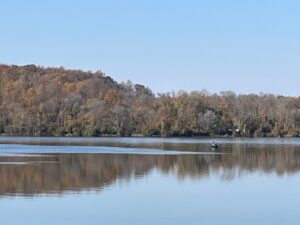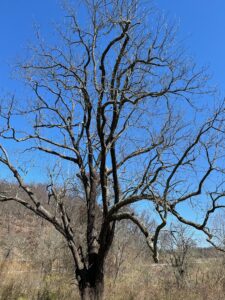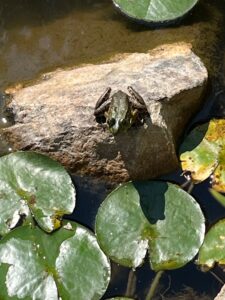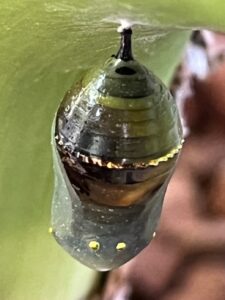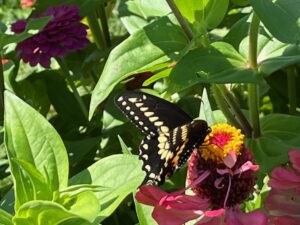The winners of the 2024-2025 Musical Theater Songwriting Challenge have been announced
By Steven Brodsky
This column featured information about the submissions process for the 2024-2025 Musical Theater Songwriting Challenge.
I’m pleased to now be able to share an announcement about the winners of this wonderful competition.
From a news release that was issued today, May 15, 2025, by the National Endowment for the Arts (NEA) and the National Alliance for Musical Theatre (NAMT):
Washington, DC and New York, NY—The National Endowment for the Arts (NEA) and National Alliance for Musical Theatre (NAMT) are excited to announce the winners of the 2024-2025 Musical Theater Songwriting Challenge. This program provides high school students with an unparalleled opportunity to develop and showcase original musical compositions that could potentially become part of full-scale musical theater productions. The winning songwriters will come to New York City this June to work with mentors and refine their songs for a special concert on Monday, June 16, at 7:30pm ET, at New World Stages and available to watch at arts.gov/songwriting and namt.org/challenge.
“The National Endowment for the Arts is proud to partner with NAMT to create the opportunity for students across the country to express their creativity and further develop their songwriting and storytelling skills,” said NEA Senior Advisor Mary Anne Carter. “The winning songwriters are in for an unforgettable experience, and we can’t wait to see their final compositions performed on June 16.”
Betsy King Militello, Executive Director of NAMT, said: “The Musical Theater Songwriting Challenge for High School Students reminds us that the future of musical theatre is bright, bold and brimming with possibility. NAMT is excited to welcome this year’s Winners to New York City. We are thrilled to help nurture these young voices and offer them a space to explore their artistry, connect with mentors and share their stories with the world. It’s an honor to stand alongside our partners in championing the next generation of musical theatre creators.”
The 2024-2025 winners are:
(grades and schools are as of the 2024-2025 school year)
Leela Kumar, an 11th grade student at Howell High School in Marlboro, New Jersey
“Dancing Through a Dream”— Ava, a high schooler, sits in the backroom of her home, guitar in hand, near the fireplace, softly strumming as she tries to write. It’s 12:23 AM—she should be asleep, but she can’t shake the weight of the moment. Yesterday, her English teacher gave her an assignment: present something meaningful to her in a 90-second speech. Ava decides to write a song on her guitar. Her best friend told her, “You can worry about what others think, or you can choose to be you.” Now, Ava is wrestling with that choice. This song is all about the vulnerability and hope it takes to step out of the shadows and find the courage to share your voice with the world.
Sydney Gray, a 12th grade student at Fairhope High School in Fairhope, Alabama
“Fall” — Meet Carlos, an ADHD high schooler who thrives on random factoids and video games! On the surface, Carlos is bright and bubbly, a very welcome personality for Nava Lee, an AuDHD teenage girl who struggles with making friends and feeling seen in her personal life. For her, Carlos is always there for Nava Lee when she needs it most, making him the bestest friend she could ever ask for. But for Carlos, the feelings between them run deeper than just friends.
Judah Brown, an 11th grade student at Owasso Preparatory Academy in Tulsa, Oklahoma
“Fool”— From the new musical Feathered, “Fool” explores Apollo’s fears for Icarus, as he enacts his plan to fly. The central conflict—one between love and loss, and between hope and inevitability—drives the song “Fool.” It is Apollo’s desperate attempt to understand whether being there for Icarus makes him the true fool in the end, or if it is foolish to abandon the one he loves.
Karsten Wallace, an 11th grade student at Bob Jones High School in Madison, Alabama
“Hello World”— A duet between a female robot infused with AI and its male creator, “Hello World” would serve as the final song in Act I of a larger musical as the song ends on a cliffhanger with the female AI Robot powering back on after her creator unplugged her because she wished to be free and did not love him. The song shifts back and forth between the female AI’s cries for liberation and its creator’s descent into madness as he slowly realizes that he has lost the only thing that he loves.
Gwendellyn Doerfler, a 12th grade student at Dewitt High School in Dewitt, Michigan
“Older”— During a get-together for her 18th birthday, Sara reveals to her friends that while she knows what she wants to do with her life, it isn’t anything like what she hoped it would be. Sitting cross legged in a sleepover-style setting, her friends begin to hum, almost absentmindedly as Sara begins the song set over crunchy chords. “Older” is from the new musical 25, which focuses on nine members of the class of 2025 as they navigate their senior year of high school.
Elaina Stuppler, an 11th grade student at Lakeridge High School in Lake Grove, Oregon
“Second Chances”— In “Second Chances”, Maria Anna Mozart sings to her brother Wolfgang and the society that cast her aside. Once a prodigy alongside him, she was forced to abandon her musical dreams at 17 due to gender expectations in the 1760s. Now, as Wolfgang returns, she refuses to be treated as an afterthought and challenges the idea of second chances, having never been given a first.
Sadie Shapiro, a 12th grade student at Montclair Kimberley Academy in Scotch Plains, New Jersey
“The Way Iamb”— Avi is a literature-loving 11th grader at an all-girls’ school amidst a mercilessly competitive student council election. After the current student body president let everyone down by choosing an awful theme for the Winter Formal, the stakes regarding the next election are high—and Avi has been secretly hired to write speeches for both major candidates. In “The Way Iamb,” Avi decides to speak to her peers from her own point of view, instead of someone else claiming her words as their own.
Ali Lewis, a 12th grade student at Mercy McAuley High School in Cincinnati, Ohio
“Why Not?”— Set in 1953, this song is sung by the character Augusta Ansel, a 76-year-old woman who is blind and nearly deaf. She lives alone in a large, cursed mansion and she is haunted by the traumatic event of her husband being murdered by a mysterious man named Victor. She doesn’t like to talk about her complicated history because it hurts too much, and so in attempting to conceal this side of herself, she overcompensates with a loud, confident personality.
Excerpts of the winning song submissions and more information about the winners are available here. Over the next several weeks, each of these songs will be professionally orchestrated. Winning students will come to New York City this June where they will work with mentors and musicians to hone their orchestrations while learning about process, technique, and production. The final compositions will be performed by Broadway artists in a concert on Monday, June 16, at 7:30 p.m. ET, available to watch live and on-demand at arts.gov/songwriting and namt.org/challenge. In addition, each winning student will receive a scholarship of $2,500, provided by the NMPA S.O.N.G.S. Foundation.
The 2025 Music Team includes Music Supervisor Dylan Glatthorn, Music Director Anessa Marie Scolpini, and mentors Andrea Daly, Timothy Huang, and Jaime Lozano. The winning songs will be orchestrated by Faye Chiao, Teresa Lotz, and Anessa Marie Scolpini. The concert casting director is Michael Cassara, CSA. More information about the Songwriting Challenge mentors is available here.
Posted 5-15-25
Cassie Meck will be performing in Servant Stage Company’s Sunday Night Cabaret Series on May 18, 2025; the performance will take place at the Magic & Wonder Dinner Theater in Lancaster County, Pennsylvania
By Steven Brodsky
… This cabaret performance will begin at 7 p.m.
Tickets are pay-what-you-will, consistent with Servant Stage Company’s mission to make exceptional theatre experiences accessible to everyone.
Visit https://servantstage.org/upcoming-cabarets/meck-cassie-cabaret for additional information and a link to reserve your tickets.
Posted 5-7-25
Shackled and unshackled listeners
By Steven Brodsky
… have been enjoying episodes of UNSHACKLED!, the iconic radio drama show, since 1950.
Episodes of UNSHACKLED! are accessible at: https://unshackled.org/on-demand/browse-all-programs/.
John 8:36: “If the Son therefore shall make you free, ye shall be free indeed.”
Note to readers: This post appeared at: https://delcoculturevultures.com/2025/05/06/conversations-about-faith/.
Posted 6-6-24, Revised and reposted 5-6-25
The National Endowment for the Arts (NEA) has announced the recipients of the 2025 NEA National Heritage Fellowships
By Steven Brodsky
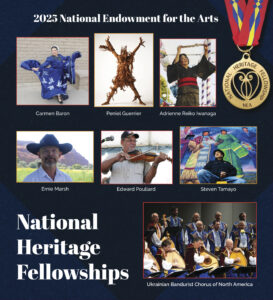
… Congratulations to the awardees.
From a National Endowment for the Arts (NEA) press release that was issued yesterday, April 17, 2025:
Washington, DC—The National Endowment for the Arts (NEA) is pleased to announce the recipients of the 2025 NEA National Heritage Fellowships, the nation’s highest honor in the folk and traditional arts. The program recognizes recipients’ artistic excellence, lifetime achievement, and contributions to our nation’s traditional arts heritage.
NEA Folk & Traditional Arts Director Leia Maahs said, “The 2025 National Heritage Fellowship awardees represent artists whose labor is often invisible in the public eye. As stewards of cultural memory, they bring us ‘home’ with dances and songs passed down from one generation to the next. They adorn everyday expressive life with artistry in manual arts, costume, and regalia that animate traditions within communities across America. The National Endowment for the Arts is honored to celebrate these accomplished artists, for their cultural knowledge, excellence towards their work, and the legacy they uphold.”
The 2025 NEA National Heritage Fellows are:
Carmen Baron, Mexican Folk Costume Maker and Dancer (Tucson, Arizona)
A trained structural and architectural designer, Carmen Baron sees the lines, colors, and proportions needed to create intricately designed custom-made costumes for young Baile Folklórico dancers throughout the state of Arizona.
Peniel Guerrier, Haitian Dancer, Drummer, and Educator (Astoria, New York)
An internationally renowned dancer and teacher, Peniel Guerrier has dedicated his life to preserving and promoting Haiti’s rich cultural heritage through dance and drumming, influenced by Haitian history and traditional Vodou practices.
Adrienne Reiko Iwanaga, Bon Odori Dancer, Teacher, and Choreographer (Saratoga, California)
Adrienne Reiko Iwanaga has preserved and revitalized the traditional Japanese folk dance of Bon Odori, sparking new interest in the art form and expanding its reach and popularity through her innovative approach and artistic contributions.
Ernie Marsh, Bit & Spur Maker and Silversmith (Lovell, Wyoming)
Characterized by high-relief engraving, engraved steel, and French Gray finishes, Ernie Marsh’s craftsmanship is instantly recognizable and known among horsemen, collectors, and fellow makers for its balance of function and beauty.
Edward Poullard, Creole Musician (Beaumont, Texas)
A third-generation Creole musician, Edward Poullard mastered various instruments throughout his musical journey and is known for teaching Creole and Cajun fiddle and accordion styles throughout the United States and Europe.
Steven Tamayo (Sicangu Lakota), Traditional Lakota Artist & Educator (Omaha, Nebraska)
Steve Tamayo has spent decades reclaiming and celebrating Lakota culture through his art, helping students deepen their knowledge of traditional activities like regalia making, drumming, and powwow dancing, which are vital to cultural preservation and unity.
Tamayo is the 2025 recipient of the Bess Lomax Hawes National Heritage Fellowship, presented in recognition of an individual who has made a significant contribution to the preservation and awareness of cultural heritage.
Ukrainian Bandurist Chorus of North America, Men’s Choral & Bandura Ensemble (Detroit, Michigan)
A musical ambassador of Ukrainian culture, music, and the bandura (a lute-harp hybrid instrument), the Ukrainian Bandurist Chorus of North America has its roots in pre-World War II Ukraine, and regularly travels for rehearsals, performances, and other community-supported events.
About the National Heritage Fellowships
NEA National Heritage Fellowship recipients are nominated by the public—often by members of their own communities—and then judged by a panel of experts in the folk and traditional arts. The panel’s recommendations are reviewed by the National Council on the Arts, which sends its recommendations to the NEA chair.
About the National Endowment for the Arts
Established by Congress, the National Endowment for the Arts is an independent federal agency that is the largest funder of the arts and arts education in communities nationwide and a catalyst of public and private support for the arts. By advancing opportunities for arts participation and practice, the NEA fosters and sustains an environment in which the arts benefit everyone in the United States. To learn more, visit arts.gov or follow us on Facebook, Instagram, X, and YouTube.
Posted 4-18-25
A New Season of Theatre Classes in Servant Stage Company’s Monday Night Drop-Ins Program is Underway
By Steven Brodsky
… Class subjects include: acting, improvisation, vocal technique, and dance.
These classes are pay-what-you-will.
From a Servant Stage Company press release issued on Febuary 14, 2025:
2025 marks the fourth year for the Monday Night Drop-Ins program. Last year’s program served 373 unique students (an 83% increase from the previous year) over the course of 64 classes, with many attending multiple classes. “It’s our goal to be a theatre home for people of all ages,” says Executive Director, Johnathan Bauer. “We want to create opportunities for those just getting started out all the way to those working on the professional level, and our Monday Night classes are a key component of that vision.”
Visit https://servantstage.org/mondays for additional information.
https://servantstage.org/
Posted 2-24-25
The responsibilities of managing a theater took a toll on William Butler Yeats
By Steven Brodsky
… and inspired Yeats to pen the poem “The Fascination of What’s Difficult” in 1912.
“The Fascination of What’s Difficult”: https://www.poetryfoundation.org/poems/43286/the-fascination-of-whats-difficult.
W.B. Yeats received the Nobel Prize in Literature in 1923 “for his always inspired poetry, which in a highly artistic form gives expression to the spirit of a whole nation.”
Posted 4-23-22
